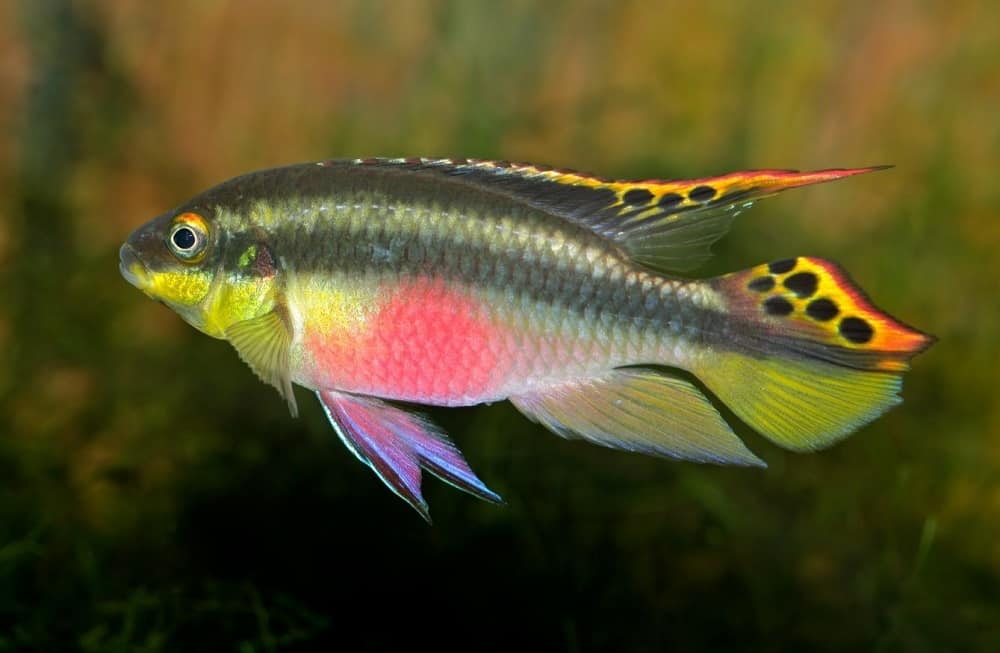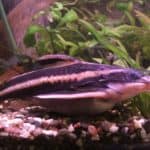If you’ve ever owned any tropical fish, you’ll sometimes know how difficult it can be to care for them. These fish can be sensitive even to the slightest change in their environment.
The last thing you’ll want after spending your hard-earned cash on some brightly colored fish is for them to be floating upside down within the week.
This dwarf fish is one of the beautiful things that you can have decorating your tank. They are very small with a pink pattern on the belly. In fact, the name of this fish itself is Latin for ‘beautiful belly’. This fish is considered a bottom dweller, although they are very peaceful.

This fish originally comes from African waters, meaning that it likes its conditions nice and warm. It likes water that is not too deep, with plenty of vegetation that it can use to hide from predators as well as eat.
So where can you find one of these fish? How hard is it to keep them in captivity? What fish are best paired with Kribensis? What should you feed this fish? What does it look like as a child or an adult? What should you feed this fish? How long do they tend to live? What’s the most effective method of keeping this fish happy and healthy?
Well, if you want the answers to these questions and a whole lot more, we would recommend that you keep on reading.
We have the full profile of this animal, including diet and the differences between the male and the female. We’ll also talk about the most common diseases that affect this fish as well as how to avoid them.
Care Guide
Tank Size
The tank doesn’t have to be too large for this fish. They are very small and bottom-dwelling, meaning that as long as they have enough space in the bottom of the tank then they should be fine.
You’ll only need around 20 to 30 gallons of space in this tank. The amount of space that you give to a fish will certainly affect its happiness and stress levels. You’ll need to make sure that this fish has plenty of room to maneuver, with plenty of covering foliage.
Tank Mates
This fish is largely very peaceful, so you won’t have to worry about it being overly aggressive. However, you will need to be sure that this fish doesn’t get bullied by angel fish or any other large fish.
This fish has also been known to nip at the fins of larger fish, which might not injure the large fish, but it may provoke them to hurt the Kribensis. Make sure that your Kribensis has plenty of room at the bottom of the tank to move and that there are no other bottom dwellers. If your fish are sharing too small a space, then they might get agitated.
If you have caves in your tank, make sure they are spaced out, as the Kribensis will get very territorial.
Same Species Tanks
You can keep this one in the same species tank and this fish is relatively calm and peaceful. You can also allow it to share a space with larger fish, as they will not attack them.
Water Parameters
The Ph level of your tank needs to be anywhere between 5.0 and 8.0. The tank needs to have a temperature of around 75 to 79 degrees Fahrenheit. The alkaline quality of the tanks needs to be somewhere around 5 to 20 degrees.
The water hardness can vary with these fish, because they are very adaptive. However, if water hardness exceeds this, then you can be certain that your fish will start to experience significant health issues such as respiratory failure and flaking scales.
What To Put In Their Tanks
You should put plenty of rock caves in your fish tank, as they like to be able to hide and rest for a long period of time. They are also very territorial when it comes to their caves, so make sure that you have more than one dotted around.
Make sure that the opening of the cave has no rough edges and ensure that there is only one entrance and that a minimal amount of light gets in. Have stable rock formations with flower pots so they have plenty of space to hide and rest. They also like to nibble on this food.
You can use various different materials for your fish’s hide, it doesn’t just have to be rock. You can use ceramic, coconuts or wood as a place for your fish to hide. Make sure that it is buried in gravel and that it is structurally sound.
Common Diseases
This fish is susceptible to a variety of diseases, one of the main ones being bacterial diseases. You’ll be able to tell that this fish has a bacterial disease if its abdomen swells up and a red streak develops on its stomach.
If your fish develops white or fluffy patches on its abdomen, then this will be a sign that it has a parasitic disease. This can be treated with medication such as Malachite Green and over-the-counter medications.
If you notice that your fish is trying to gasp for air and jumping above the surface of the water, then this could be a sign that the quality of the water is substandard and that this might be causing your fish to have developed a physical disease.
Food & Diet
The Kribensis is an omnivorous fish, so it will eat any number of artificial pellets and other types of vegetable-based foods. It will also eat frozen brine shrimp, daphnia, mosquito larva and bloodworm.
You should make sure that you feed your fish a diverse diet so that it remains healthy. We would recommend a mix of meat and vegetables to make sure that you have everything that you need to stay fit and active and keep disease at bay.
Lifespan
This fish will generally live no longer than 5 years if kept in good conditions. However, there have been reports of this fish living for 6 or 7 years if kept really well.
Appearance
This fish has a very distinctive pink belly with a multicolored fin that arches up near its back. It has distinctive spots on its tail, which is also fringed with a rainbow patterning. It has two fins underneath which are tinged with blue.
Size
This fish is described as being a dwarf breed, so it is very small, possibly some of the smallest fish that you can get from your local aquarium. The males of the species will grow up to 4 inches, with the females being slightly smaller at 3 inches.
Behaviour & Temperament
This fish is very relaxed and will blend in with most other types of fish. They are very solitary and often stick to themselves, although they do tend to get very territorial over their caves. They are very prolific breeders, and will often be seen to be herding their babies from one end of the tank to the other.
Breeding
Once you have selected a pair of Kribensis, they are usually very easy to breed. Make sure that your pair is young and healthy. Make sure that you stick with one pair of fish. If you put two males in the tank, you can be certain that they will fight and two females will also fight for the attention of the male.
When they have given birth to their young, this fish will become very aggressive and will try to defend their young from opposing fish. Make sure that they have at least 20 gallons of tank space in which to rear their young.
If you have a Ph level of around 7.0, then you can be sure that the number of females and males that will be given birth will be roughly even. Make sure that there is at least 3 mm of gravel at the base of your tanks so that the spawning pair of fish can dig down to lay their eggs.
Gender Differences: Male Vs. Female
The male is slightly longer than the female, being around 4 inches to the female’s 3 inches. The males have much more pointed fins than the females, who tend to have rounded fins. The female has a very bright purple patch on the belly, whereas the male is slightly fainter.
Fun Facts
- This fish will often usher its young from one end of the tank to the other after they have been born. This will be to keep them safe and protect them from predators in the wild.
- This fish is used to shallow and clean water, so you’ll need to make sure that the water is cleaned regularly.








